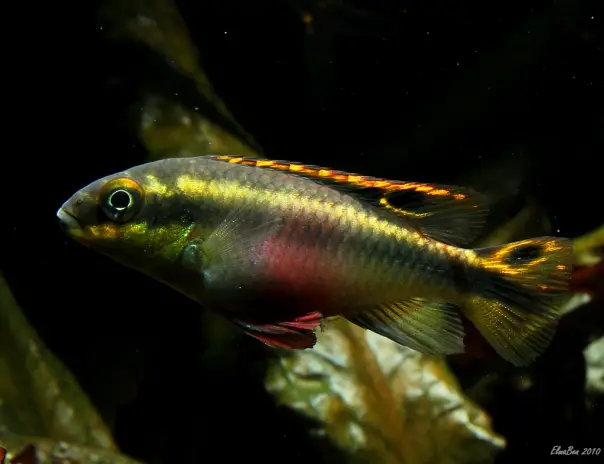Sex ratio in kribensis influenced by environment
Scientists from the University of Alberta, Canada, have ascertained that the pH of water influences both sex ratio and male phenotype in the kribensis, Pelvicahromis pulcher.
P. pulcher is a small cichlid native to western Africa and an enduringly popular aquarium fish. Males exist in two colour forms with those possessing a yellow operculum (YO) monogamous and those with a red operculum (RO) facultatively polygynous, i.e., they may breed with a single or multiple females simultaneously.
Female colour pattern may vary somewhat but they so not exist in more than a single colour form.
Rubin (1985) reported environmentally influenced sex determination (ESD) in kribensis, with a greater proportion of males being produced under acidic than neutral conditions, although as in other fishes exhibiting ESD the environmental influence on sex is not absolute and substantial numbers of both sexes are normally produced regardless.
The new study, to be published in a forthcoming issue of the journal ‘Zoology’, aims to confirm ESD in this species, determine whether pH conditions influenced the expression of alternative male morphs, specifically, the ratio of RO to YO males, and determine whether pH affected individual differences in behaviour within each sex.
8 pairs of fish were used and maintained separately with temperatures in all aquaria stabilised at 26°C and pH initially 6.0 ± 0.1.

Females do not exist in different colour morphs though they may exhibit some individual variability © Elma Ben
After 48 hours of acclimatisation 4 tanks were selected randomly and pH was reduced to 5.5 ± .01 while in the remaining 4 it was raised to 6.5 ± 0.1. All pairs spawned within 21 days and the pH levels were maintained at the experimental levels for a further 30 days.
After 60 days the adults were removed and juveniles split into larger aquaria to prevent over-crowding where they were allowed to grow until they reached 330 days of age at which point the sexes were separated and counted.
More females than males were produced in both pH 5.5 and 6.5, but a greater number of males and RO males were produced at pH 5.5. A heightened trend towards aggression, determined by using a mirror and counting the number of bites by individual fish during a period of 600 seconds, was also recorded in the pH 5.5 fish.
The researchers concluded that since the pH of water in the natural habitats of P. pulcher ranges between 5.5-7.0 depending on locality and season, and that the species breeds year-round, fish born in the dry season ought to exhibit a different sex ration than those from the rainy season.
Fish may also face different challenges depending on when they are born, and the relative fitness of RO males, YO males and females may thus depend on developmental conditions to an extent.
An additional discovery was that male colour morph is also affected by developmental conditions although the RO and YO characters are permanent and remain with an individual throughout life.
For further information please refer to the full paper, currently available only as a corrected proof in press: Reddon, A. R. and P. L. Hurd. Water pH during early development influences sex ratio and male morph in a West African cichlid fish, Pelvicachromis pulcher. Zoology (2013), http://dx.doi.org/10.1016/j.zool.2012.11.001
P.S. we’d be very interested to hear from anyone that can offer more information about the opercular colour in males since we’ve never seen it mentioned in aquarium literature, so please get in touch via the comments below if you’ve anything to add!
Category: News, Science | Tags: aquarium, cichlid, kribensis, Pelvicachromis, Zoology | 3 comments »



March 27th, 2014 at 6:34 pm
The colour possibly gots to do with different species; P. pulcher is not the same as P. kribensis, but they look similair.
March 30th, 2014 at 10:29 pm
Thanks for this interesting update!
I read the original 1997 study of the male color morph / behavioral type phenomenon a couple of years ago. Here’s the abstract: http://link.springer.com/article/10.1007%2Fs002650050391
What I have been wondering about since then is the heritability of the RO trait. Martin & Taborsky (1997) state that it appears that only RO males can have RO sons. But in my tank I did in fact have several RO sons from a YO (aquarium strain) male.
I don’t think I’ll cash out for the new paper, but I’d be interested to hear if the new study says anything about whether YO fathers can have RO sons.
April 5th, 2014 at 11:28 am
Andreas, if you pm me your email address I can send you a copy.